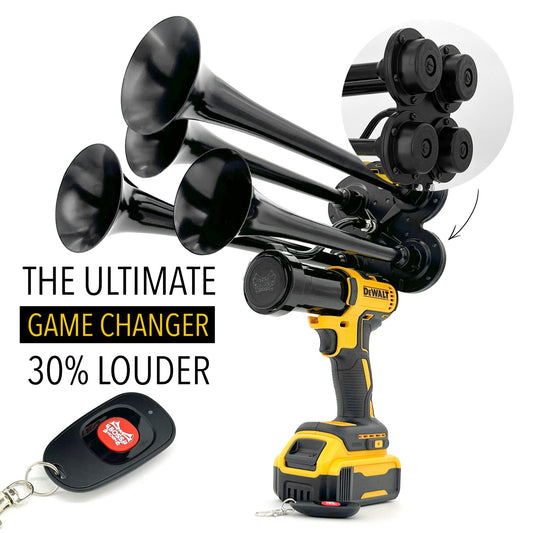An attention-grabbing fact about air horns is that they are commonly used in various settings to produce a loud and powerful sound. These horns, which are typically designed to be portable and easily operated, can effectively capture everyone's attention in crowded places or emergency situations. The loudness of air horns makes them an indispensable tool for safety, communication, and entertainment purposes.
Air horns have a long-standing history, dating back to the early days of maritime communication. In the past, ships relied on massive brass horns to signal their presence or communicate with other vessels. As technology advanced, these large horns were replaced by smaller, more compact versions powered by compressed air. Today, air horns are commonly used in marine, automotive, and sporting events industries.
The significance of air horns lies in their ability to produce a sound that is impossible to ignore. These horns are designed to create a high decibel level, which is the standard unit for measuring loudness. To put it into perspective, a typical conversation between two people is around 60 decibels, while a rock concert can reach levels of 100 decibels. Air horns, on the other hand, can produce sounds exceeding 120 decibels, making them exceptionally effective at grabbing attention and alerting others in emergency situations.
Despite being an effective means of communication and safety, the loudness of air horns can sometimes pose a challenge. In certain cases, such as indoor sporting events or music venues, the use of air horns in close proximity to individuals can be extremely uncomfortable or even harmful to their hearing. To address this concern, many venues and events have implemented regulations or guidelines on the proper use of air horns, ensuring that people's safety and comfort are maintained.
Overall, the loudness of air horns makes them an invaluable tool for various applications. Their ability to create an attention-grabbing sound is crucial in emergency situations or scenarios where effective communication is necessary. However, it is important to use air horns responsibly, keeping in mind the potential impact on individuals' hearing. With proper guidelines in place, air horns can continue to serve their purpose while ensuring the safety and well-being of those around them.
How Loud Are Air Horns: Understanding the Decibel Levels and Impact
Air horns: the powerful sound-making devices that are often associated with sporting events, emergency situations, and even marine communication. But have you ever wondered just how loud these air horns can be? In this article, we will delve into the decibel levels of air horns and explore their impact on our hearing and surroundings.
When it comes to measuring sound intensity, the unit of measurement used is decibels (dB). Generally, the louder the sound, the higher the decibel level. The decibel scale is logarithmic, meaning that an increase of every 10 dB represents a sound that is perceived to be twice as loud. This scale allows us to understand and compare the relative loudness of different sounds, including air horns.
Air horns can emit a wide range of decibel levels depending on their design, size, and intended use. While the precise decibel level can vary between different models, it is not uncommon for air horns to produce noise levels exceeding 120 dB. To put this into perspective, a normal conversation typically registers at around 60 dB, while a rock concert may reach 100 dB.
The intense noise produced by air horns serves various purposes. In sporting events, they create a thrilling and energizing atmosphere, encouraging crowd participation and raising team spirit. In emergency situations, air horns are utilized to command attention and alert people to potential danger. Similarly, in marine environments, air horns are essential for communication and signaling between vessels.
However, it's crucial to note that prolonged exposure to high decibel levels can have detrimental effects on our hearing. Sounds above 85 dB can cause hearing damage after extended periods, with the risk increasing significantly as the decibel levels rise. Therefore, it is vital to take precautions when operating or being exposed to air horns, such as using hearing protection devices and limiting exposure time.
Now that we have explored the basics of decibel levels and the impact of air horns, the next part of this article will delve deeper into the specific decibel levels of different air horn models and provide tips for safely operating and enjoying these powerful sound devices. Stay tuned to discover more about the fascinating world of air horns and their influence on our auditory experiences.
Decibels and Air Horns
Air horns are known for their extremely loud and piercing sound. They are commonly used in various situations where a loud noise is required to capture attention. The loudness of an air horn is measured in decibels (dB), which is a unit used to quantify sound intensity.
Decibels are a logarithmic scale, which means that a small increase in decibel level represents a significant increase in sound intensity. For example, a sound that measures 80 dB is twice as loud as a sound that measures 70 dB. It's important to note that the human ear has a limited range of sound tolerance, and prolonged exposure to sounds above a certain decibel level can cause hearing damage.
The Decibel Levels of Air Horns
Air horns are designed to produce an extremely loud and attention-grabbing noise. The decibel levels of air horns can vary depending on the specific model and type. However, most air horns produce sound levels that range from 100 dB to 130 dB.
An air horn that emits a sound level of 100 dB is considered very loud and can be compared to the noise level of a revving motorcycle or a chainsaw. At this level, exposure for more than 15 minutes can cause hearing damage. As the decibel level increases, so does the potential risk to hearing.
At 120 dB, an air horn's noise is comparable to the sound produced by a rock concert or a jet engine taking off. Prolonged exposure to this level of sound can cause immediate and severe damage to the ears, leading to permanent hearing loss.
Some air horns, particularly those used in larger marine vessels or industrial settings, can reach decibel levels as high as 130 dB. To put this into perspective, a gunshot is typically around 140 dB, so air horns at 130 dB are incredibly loud.
The Impact of Loud Air Horns
The loudness of air horns serves various purposes across different industries and settings. In sports events, air horns are commonly used by fans to show support and enthusiasm for their teams. They can also be heard in emergency scenarios, such as on ships or during major evacuations, to signal danger and grab people's attention.
However, it's crucial to use air horns responsibly and be mindful of noise pollution. The loud sound produced by air horns can be disturbing and irritating for those in the vicinity, especially if used excessively or inappropriately. Therefore, it's essential to observe local noise regulations and guidelines to prevent unnecessary disturbance and protect the hearing of individuals in the area.
Statistics on Air Horn Noise Levels
- The average decibel level of an air horn is between 100 dB and 130 dB.
- Air horns at 100 dB are as loud as a revving motorcycle or a chainsaw.
- Air horns at 120 dB can be compared to the noise level of a rock concert or a jet engine taking off.
- Some air horns can reach decibel levels as high as 130 dB, which is close to the sound of a gunshot.
https://youtube.com/watch?v=Pnjt5Nej7-o
FAQ: How Loud Are Air Horns?
1. What are air horns and how do they work?
Air horns are powerful acoustic devices that emit a loud sound by using compressed air. They are commonly used to gain attention or make warnings in various settings. Air horns have a distinctive design, typically consisting of a horn-shaped resonator and a diaphragm. When the diaphragm vibrates due to the release of compressed air, it creates a loud noise that can travel over long distances.
Important information:
- Air horns use compressed air to produce a loud sound.
- They have a unique design with a resonator and diaphragm.
- The loud noise created by air horns can travel far.
2. Where are air horns commonly used?
Air horns find a wide range of applications across different industries and activities. They are often used in maritime settings, such as on ships or boats, where they serve as crucial signaling devices. Additionally, air horns are prevalent in sporting events, especially outdoor ones, to energize the crowd and show support for the team. They are also employed in emergency situations, construction sites, and certain transportation vehicles.
Important information:
- Air horns are commonly used in maritime settings and sporting events.
- They can be found in emergency situations and construction sites.
- Some transportation vehicles utilize air horns.
3. Why are air horns loud?
Air horns are designed to be loud to ensure their effectiveness in capturing attention or providing warnings in various situations. The loudness of air horns is mainly achieved through the powerful release of compressed air, which causes the diaphragm to vibrate rapidly. This rapid vibration produces a strong sound wave that is highly audible, even in noisy environments.
Important information:
- Air horns are intentionally designed to be loud.
- The release of compressed air and rapid diaphragm vibration contribute to their loudness.
- Air horns can be heard clearly even in noisy surroundings.
4. Are all air horns equally loud?
While air horns are generally known for their powerful sound output, their loudness can vary depending on several factors. The specific design and construction of an air horn can significantly impact its loudness. Factors such as the air pressure used, the size of the horn, and the material it is made from can all affect its overall sound intensity. It is important to note that different air horns may have different sound profiles, frequencies, and volumes.
Important information:
- The loudness of air horns can vary based on design and construction.
- Factors such as air pressure, horn size, and material contribute to their sound output.
- Different air horns may have varying sound profiles, frequencies, and volumes.
5. Can air horns cause hearing damage?
Air horns produce high-intensity sound levels that have the potential to cause hearing damage if proper precautions are not taken. Prolonged exposure to the loud noise emitted by air horns can lead to temporary or even permanent hearing loss. It is crucial to use air horns responsibly and avoid overexposure to their sound. When using air horns in close proximity to others, it is advisable to ensure they are aware of the loud noise that will be generated.
Important information:
- Air horns can cause hearing damage if not used responsibly.
- Prolonged exposure to their loud noise may lead to temporary or permanent hearing loss.
- Awareness and caution should be exercised when using air horns, especially in close proximity to others.
Conclusion
- Air horns are extremely loud and can reach noise levels of up to 143 decibels or even higher.
- The decibel level of an air horn depends on various factors such as the design, size, and type of horn.
- These powerful devices are commonly used in emergency situations, sporting events, and marine environments.
- The loudness of an air horn makes it highly effective for alerting and getting attention over long distances.
- Prolonged exposure to air horn noise can lead to hearing damage, so it's crucial to use them responsibly and protect your ears.
- It is important to follow local regulations and guidelines regarding the use of air horns to ensure safety and prevent noise pollution.
- Overall, air horns provide an efficient and attention-grabbing sound signal in various situations, but their loudness should be respected and used judiciously.














